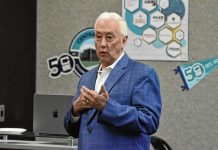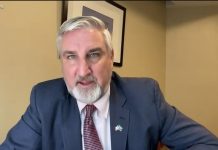Mayor Kristen Brown’s Riverwalk bridge proposal is in limbo after city council members asked for more options to connect the People Trails segments under the Second and Third street bridges.
Council members decided not to vote Tuesday night on a resolution to approve spending $282,500 in tax-increment financing district funds to pay for engineering work on the bridge project.
Council members told the estimated 35 people at the meeting that the project to connect the two People Trails segments downtown is not dead, but they want more options to explore to connect them beyond the Riverwalk bridge proposal advocated by the mayor.
Brown did not attend the meeting, saying she had a personal matter to attend to.
Brown: It’s politics
The council’s “see more options” statement was a red herring, Brown said Wednesday morning, describing the council meetings as a charade. Council members know exactly what they are going to do before they arrive at the council meetings, she said.
The mayor said she believes the council has effectively killed the Riverwalk project, which she has been working on for a year and a half.
Riverwalk was a great project that could serve as an anchor piece to activate a redeveloped riverfront for the city, the mayor said. The project was an opportunity to do something remarkable for the city and its residents and to make the riverfront a destination in Columbus, she said.
The mayor said she hired United Consulting, an Indianapolis engineering firm, which assured the city there is no practical option other than a pedestrian bridge to connect the two trails.
Brown said she has walked the area with Columbus Parks Foundation officials and city council members, including council president Tim Shuffett, Ryan Brand and mayor-elect Jim Lienhoop, and explained why the bridge is the best solution.
She repeated the list of barriers that prevent the city from building on the riverbank, including the sanitary sewer that runs along the river and the close proximity to the Pump House, which has been sold to developer Tony Moravec to become a brew pub.
The trail cannot be taken through the Pump House property and can’t go on the bank, as the slope cannot be Americans with Disabilities Act-compliant if the two trails need to come to street level, she said.
“I’ve explained all this,” she said. “I don’t know what other options there would be,” she said. “What other options do they want to explore?”
Brown described the council’s stance on the matter as political, three months after she was defeated by Lienhoop for the Republican nomination for mayor.
Council member: Why United?
Redevelopment Director Heather Pope represented the Columbus Redevelopment Commission at Tuesday night’s meeting, explaining the commission had approved hiring United Consulting to do engineering work for the project, subject to council approval.
The redevelopment commission sent the proposal to the council first as the estimated $2.5 million Riverwalk project eventually would be in the council’s hands. The council must approve any expenditure over $500,000, including city redevelopment projects.
The redevelopment commission did not want to spend money on the engineering if the council is not in favor of the project, she said.
Council member Dascal Bunch questioned why the council was being asked to consider only one engineering company, when five companies had submitted proposals to engineer the project.
Council members have said in earlier interviews that in a city engineering evaluation of the proposals, which has not been made public, United Consulting did not rate as the top firm for the project.
Frank Jerome, a council member who serves on the redevelopment commission, repeated his objections to Riverwalk, saying the city needs to comprehensively deal with problems along the riverbank and in the East Fork White River dam instead of building the Riverwalk.
He described the bank area near where the Riverwalk would pass as a dump site, filled with concrete and rebar, and covered in trees, which shore up an eroding riverbank.
The city needs to repair a dam located between the Second and Third street bridges that he says is causing erosion near an old city landfill, which could be leaching substances into the river, Jerome said in an earlier redevelopment meeting.
He also wants the area where concrete and exposed rebar are piled on the riverbank to be cleaned up and replaced with a retaining wall similar to what Columbus Regional Hospital used to shore up Haw Creek’s bank to prevent flooding.
“This is out of order,” Jerome told the council Tuesday night about pursuing the bridge building first. “The bridge might be the best solution, but I think it’s premature,” he said.
It is highly unlikely the Indiana Department of Natural Resources would approve what Jerome is proposing, the mayor said Wednesday. Residents along the river north of Columbus would have concerns that the retaining wall would fill in so much of the floodway, she said.
Park foundation involvement
Tasha Mann, secretary for the Columbus Park Foundation, read a statement at the council meeting that the foundation supports the connection of the People Trails in the downtown area, but the organization was not a part of the process in coming up with the bridge plan.
After some questioning as to whether that meant the foundation was in favor of the bridge proposal, council member Kenny Whipker pointed out there had been a lack of collaboration between the city and park foundation, and the foundation needs to be involved.
Mann said perhaps the bridge is the solution or it might not be, but the foundation wishes to be at the table to discuss and look at all the options.
Council member Frank Miller questioned whether the bridge connection was really the best option.
“Here we’ve got a beautiful looking bridge,” Miller said, although referring to the overall $2.5 million project cost as pricy.
Instead, Miller asked that the redevelopment commission and the council start over and designate where TIF dollars should be spent on a priority basis, including on projects such as the Mill Race Amphitheater and others that have been proposed.
“What’s No. 1, No. 2 and No. 3, and then move forward,” he said.
Council member Ryan Brand said if the city has the opportunity for a public-private partnership to fund the People Trails connection downtown, that’s the way it should go.
“Is there a top end to this project?” he asked about the cost. “What is the number for 600 feet of trail? … We can get a lot of trail done for $2.5 million,” he said.
Council President Tim Shuffett said it was critical that the city look at all avenues to connect the trails and take time to look at all the choices.
The mayor said she is open to anything that is physically possible as an alternative, but she has not seen any other options coming from the council.
“If they want to give us one, we will apply city resources to that,” she said, adding that includes options provided by the park foundation.
[sc:pullout-title pullout-title=”About the Riverwalk project” ][sc:pullout-text-begin]
Estimated total cost: $2.479 million
Companies that provided proposals to design Columbus’ Riverwalk:
- United Consulting, Indianapolis
- Structurepoint, Indianapolis
- Strand Associates, Columbus
- Clark Dietz Inc., Indianapolis
- CDI Civil Design, offices in Illinois, Kentucky and Missouri
Project would involve building an estimated 600-foot concrete bridge that could connect the People Trails segment under the Second Street Bridge with the trail segment under the Third Street Bridge to complete a loop of the trail downtown. It is projected to be visible to those entering downtown on State Road 46 and State Road 11 from the west side and is being planned in conjunction with the development of the historic Pump House into a brew pub. Mayor Kristen Brown has proposed using tax-increment financing district money to pay for the project.
[sc:pullout-text-end]




